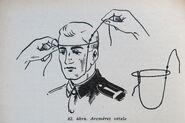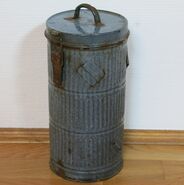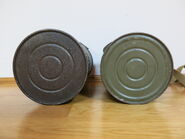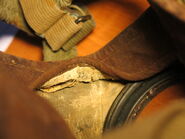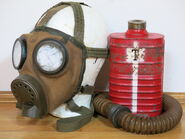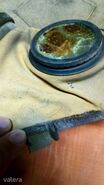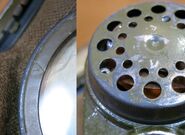The Hungarian 34M was designed before the Second World War and was used until the end of the 1990s in some form. Originally it was issued to the Magyar Királyi Honvédség (Hungarian Royal Army), used by the Légoltalmi Liga (predecessor of the Polgári védelem - Civil Defence) after the war by Magyar Néphadsereg (Hungarian People’s Army) later it was also used by the Polgári védelem (Civil Defence).
Overview[]
It is a full face mask made of a single sheet of rubber-coated light brown canvas (darker or greener canvas was used as well) formed by 3 seams, 2 on the forehead and one on the chin. It seals on the face via 4cm wide goat leather stitched to a rubber-coated canvas verge and folded out to the outside of the mask where the seam is sealed by a thin rubber layer. The shatterproof (it is composed of two glass layers and a thin sheet of cellulose between) glasses are crimped to metal assemblies which are pressed to the faceblank permanently. The 7 pointed, adjustable and elasticated harness is composed of three pieces and sewn to the facepiece. The middle forehead straps is hooked over a metal roller frame and sewn to the outer forehead straps, so these can slide freely and automatically adjusts to the shape of the head. On the nape the temple straps and the strap of the roller frame are hooked up to a metal piece which is riveted to a leather pressure equalizer rectangle. The third part near the bottom would be wrapped behind the neck of the user and hooked to the left side of the mask to provide a tight seal and to prevent accidentally taking off the mask. There is a carrying strap on the bottom back of the mask and a chinstrap inside as well. The valves are placed in one dark olive-green painted oval aluminium alloy piece. The "tulip" styled exhale valve is on top of the downwards facing 40mm DIN intake covered with a threaded grid. Unlike the Cold War Hungarian masks, the size 1 is the biggest and size 4 is the smallest.
Filter[]
33M légtisztító[]
Main article for the firefighter filter: 33M légtisztító
Main article for the industrial filters: 33M légtisztító
Big flat box filter with grooves on the side. The firefighter filter was multi-purpose and painted red with a capital T in white frame, the other industrial ones were painted with the appropriate colour for the protection type.
34M and 41M szűrőbetét[]
Main article: 34M and 41M szűrőbetét
The 34M filter comes in a cylindrical canister with a cap and sticker sealing the bottom. The filter was redeveloped in 1941 hence the new designation is 41M.
Carriers[]
Leather frame carrier[]
Generally called as "Hordszíj" (carrying strap) is a basic leather shoulder strap with additional smaller straps to fix the filter, so it is not capable to hold the mask inside as it was meant to only carry the filter when the mask is in use.
Bag[]
The "34M hordtáska" is made of canvas with a leather bottom. The bag features a single adjustable shoulder strap with one end sewn to the bag while the other connects to the D ring on the bag with a rotating spring loaded hook. This was done like this because, compared to other similar bags, rather unusually the bag was worn on the back. The lid can be closed with a normal buckle and the little pocket under the lid is for the spare antifog inserts, early bags have rivets on the top corners of the pocket.
Canisters[]
The first canister used with the mask is called "Fém horddoboz" (Metal carrying case). It was used with the mask since before the war by Légoltalmi Liga workers and civil defence workers of private companies.
Later the canvas bag was changed to the "42M Horddoboz" metal cylindrical box lined with cardboard (very similar to the German ones). It has a metal frame on the inside lid which is for the anti-fog inserts but sometimes the Gázseb-csomag (Gas wound kit - decontamination kit) was stored there as well. The carrying strap is fixed to the canister on two points to the side. There is an other short strap connected to a hook which was meant to fix the bottom of the canister to the belt. The military used ones were painted brown, after the war it changed to green. The civilian ones were enamel coated and lacked the normal carrying strap, instead it had a a handle on the lid to which a strap was connected. It is believed that the 42M is the copy of the Yugoslav M-33 canister. Because Hungary helped Germany in the invasion of Yugoslavia (1941), hence Délvidék (now part of Serbia) became Hungarian territory again. The war booty contained masks too which were given to Légoltalmi Liga. And the M-33 canister is very similar to the not much later 42M making the speculations quite valid.
Variants and their kit[]
Establishing that in which era was that mask made can be tricky just by the furniture, much more easier by markings.
Pre-war and war models[]
Military[]
The war production masks have dark olive-brown colored aluminium valve houses, the eyepiece assemblies and other metal parts are made of chemically treated brass giving them a thin black protective oxide layer, these metals are non-magnetic. The sealing leather is brown and the intake sealing ring is natural beige colored. The 42M carrying canisters are either dark green or light brown coloured (soldier slang for the colour called it liba - "goose") and always has a metal hook to fix the canister to the belt.
At the end of the war for a brief time the rubber was changed to a black synthetic (BUNA) one and the sealing leather verge is sometimes white on these, some are missing the H.S. sign on the inside of the valve housing. But in other aspects these look like a normal war-era military model, even sporting a KÁB stamp.
The kit contained:
- 34M mask
- 34M or later 41M filters
- 34M bag or 42M carrying canister
- 3 pairs of anti-fogging inserts and a pair of fixing C-rings or anti-fogging soap
- piece of cloth
Fire brigade[]
The pre-war firefighter variant, called T. gázálarc (Hungarian: Tűzoltó gázálarc - "Firefighter gas mask") or before 1936 as 33M tűzoltóálarc (not to confuse with the 33M polgári cselekvő gázálarc), the mask had a flatter exhale valve cover and a bit different valve housing, otherwise, the mask was identical to the army variant except that the harness adjusters are not treated. It was used with German-made CO filters and Mercur T. gázálarc filter and hose. The filter was hang on leather straps. For the Ruthenians in Hungarian occupied Transcarpathia it was called П. противогазъ (Ukrainian: Пожарный противогазъ - Pozharnyy protivogaz).
The kit contained:
- 34M mask (officially the mask is called 33M tűzoltóálarc)
- 33M filter (firefighter variant)
- leather carrying strap
- 3 pairs of anti-fogging inserts and a pair of fixing C-rings or anti-fogging soap
Civilian[]
The civil defence variants, called M. gázálarc (Hungarian: Munka gázálarc - "Work gas mask"), sometimes featured unpainted raw brass metal parts (the eyepiece assemblies are sometimes treated) and came with various carriers. For the Ruthenians in Hungarian occupied Transcarpathia it was called Р. противогазъ (Ukrainian: Pабочій противогазъ - Rabochiy protivogaz). Just like the military models each mask features a KÁB stamp.
The kit contained:
- 34M mask
- 34M or later 41M filters
- 34M bag, "Fém horddoboz", paper carrier or 42M carrying canister
- 3 pairs of anti-fogging inserts and a pair of fixing C-rings or anti-fogging soap
Rebreather facepiece[]
This variant is identical to the civilian but was modified to use with rebreathers. The older type valve house was used, the exhale valve was removed and the hole was sealed. The inhale valve was removed then the valve fixing part was drilled through to mount the oral-nasal cup clamper ring with a screw. It didn't have an exact kit.
VPU and radioist variants[]
There is only a very little information about the use of microphones with 34M facepieces. The fact that there are 3 different versions but the only photographic evidence features the one type which is missing from written documents makes this topic very unsure compared to the other parts of the 34M history.
The first and most well-known one is a modified T. gázálarc facepiece with a microphone threaded in place of the exhale valve, hence the 33M type exhale valve on the left cheek was added. The microphone is connected to a big speaker (so this is an early and bulky VPU) worn on the chest while the battery is probably worn on the back. This variant cannot be used with normal 34M masks because the filter connection is not angled downwards that much as on the T. gázálarc so the filter gets in the way of the microphone. The famous photo which was made in 1937 shows a man who is wearing a 35M helmet with M. KIR. POSTA (Magyar Királyi Posta - Hungarian Royal Post) sign, this helmet was issued to the workers of the post who were the part of the gas and air defence unit of the organization. The post was responsible for the telephone lines and their services were overall more important than nowadays this is why the air and gas defence was taken very seriously.
The second variant also connects to the post. According to the A m. kir. kereskedelemi- és közlekedésügyi miniszter 1939. évi 114.611. K. K. M. számú rendelete Hungarian produced and Italian masks made by Pirelli are allowed to be mounted to telephones if the owner of the phone requests it. The modification can be only made by the post. From the description of the decree it can be stated the mask this way became a stationary device and can be dismounted by the post only.
The third variant is the 43M gázálarc mikrofontoldat (gas mask microphone extension). There is literally no other information about it.
Industry[]
The industry used the 33M tűzoltóálarc with 33M légitsztító based industrial filters.
The kit contained:
- 34M mask (officially the mask is called 33M tűzoltóálarc)
- 33M filter (industrial variants)
- leather carrying strap
- 3 pairs of anti-fogging inserts and a pair of fixing C-rings or anti-fogging soap
Post-war models[]
Early post-war[]
These masks were made after 1946 but before 1948 for military use, older masks weren't refurbished, however most parts were made during the war, except the steel parts which were used to mostly replace brass elements but mixed brass-steel parts aren't uncommon. The canvas on the faceblank sometimes is very rough and feels cheap compared to the masks made before or during the war the rubber stayed the black synthetic one but some features the gray natural one. The colour of the painting on metal parts, filters and carrying canisters is very diverse, changing between light brown to grass green.
The kit contained:
- 34M mask
- 41M filter
- 42M carrying canister
- 3 pairs of anti-fogging inserts and a pair of fixing C-rings
Later post-war[]
These masks were made after 1951, at the start for both military and civil defence use but after the mid 1950s only for civil defence uses. The furniture and painting is more standardized compared to the earlier post-war ones but brass parts and difference in the painting isn't rare either. Metal parts are made of steel, except of course the valve housing. Painting is grass green or its shades on every metal part, including filters and carrying canisters.
The kit contained:
- 34M mask
- 41M filter
- 42M carrying canister, or rarely 34M bag
- 3 pairs of anti-fogging inserts and a pair of fixing C-rings
Industry[]
Called Ipari gázálarc, made after 1951 till 1967, the quality and standardization is behind the masks made for the civil defence at the same time. It has mostly black rubber inside and sometimes come in the dark green colored canvas on the outside. Sometimes it lacks painted metal parts which are mostly steel alloy. But the matte black or green painted metal parts are much more common. The peripheral leather seal is not folded out but just sealed with rubber cement on the edge. Later it was succeeded by the 67M.
External information[]
Development[]
The 28M deemed too time consuming, difficult and expensive to manufacture, the army also didn't like the hose which hindered the performance of the soldier and the non-adjustable straps. To accomplish the new requirements the modernisation of the 28M started around the same time, in 1933, as the development of the 33M started and the first model came out about the same time. For the first look the mask remained really similar, mostly because of the used materials and the shape of the facepiece didn't change much from the later 28M masks which had a simplified structure. However the eyepieces, valve housing, the shape of the facepiece to fit the new valve housings and the harness system were changed:
- The eyepieces are now crimped to a permanently placed part, not threaded. This makes the replacement of the eyepieces more difficult but the manufacturing is much easier.
- The place of the filter connection and the exhale valve were switched, this makes the use of a small, lightweight filter better.
- The harness is now adjustable and stronger, each strap contain 3 springs instead of 2.
The first model was the 33M tűzoltóálarc which came out in early 1933, it was fine for the fire brigade but because it was intended to use with a hose the intake points downwards too much so with a smaller filter directly threaded on the mask it can be uncomfortable since the filter blocks the head tilting forward. The intake valve is also missing in the T. gázálarc because it was placed in the filter so using it with a smaller filter is again not the best. The placing of the exhale valve was too complicated too, this housing consists of 9 parts. For the army which needed a new smaller and lightweight filter these issues required a different valve housing which came out in 1934. In this housing the exhale valve still has a funnel where it can sit and it has an intake valve too, the exhale valve lid was also updated, this housing consisted of only 7 parts but was still a bit complicated to cast. The even newer housing came out in circa 1938, this one was optimised to war economy. Most notably the exhale vale funnel was removed and is a bit lighter.
Price[]
- The 34M kit costed 25 Pengő (the mask was 14 Pengő) in 1936 which is nothing compared to the original price of the 28M whit its 113 Pengő price (the Népgázálarc was 13 Pengő). During the war the kit costed 19,50 Pengő.
- The M. gázálarc kit costed 23 Pengő with bag; 18,50 Pengő with cardboard carrier.
- The T. gázálarc kit costed 50 Pengő but after 1936 it was just 45 Pengő.
Manufacturers[]
Before and during the war the facepiece, bag and filter were assembled and tested by Mercur Műszaki és Vegyipari Rt. in Budapest at Illatos út 9., the average production was 100000 gas masks (note that this number probably includes Népgázálarc as well) in a year and 500000 filters (41M) per month. The activated charcoal, which was originally imported from Germany, distributed by Lurgi Gesellschaft für Wärmetechnik mb. was changed to the domestically produced one in 1937. It was made by Ipartermék Értékesítő Rt. based on the license of the Italian I.A.C. with changes and updates implemented. The rubber-coated canvas was made by Magyar Ruggyantaárugyár Rt., the valve housings were casted by Hofherr-Schrantz-Clayton-Shuttleworth Magyar Gépgyári Művek Rt., hence the H.S. sign moulded into the inside of it on many masks, however this sign is missing on some which were made during the war and most post-war made or used valve housings also lacking of this sign so there were other manufacturers possibly. Other metal parts were made by Magyar Fémlemezipari Rt. Canvas for the bags was manufactured by Szegedi Len- és Kendergyár. The carrying canisters were made by Budafoki Zománcárugyár, about 40000 a year. Only the antifog inserts were made abroad by Auer in Berlin, however later this was also made by Mercur. In 1944 the gas mask production of Mercur was moved to Eger (town in Northeastern Hungary) to avoid damage by the American bombing campaign against Ferencváros train station, which was among the most important marshalling yards in Central Europe that time, to what Illatos út 9 is very close. In Eger the production was placed in the factory of Egri Lakatos-, Lemez- és Fűrészárugyár Kft. Until 1940 about 1 million were made and till the end of the war approximately 1,5 million were produced.
Shortly after the war the production was placed back to Budapest, Illatos út 9., where production continued but in much smaller numbers. In 1948 the annual production was only 2000 gas masks and 15000 filters per month, these were assembled from parts produced during the war. This year the production stopped until 1951 when the factory was restarted as 1004. sz. Vállalat (unofficially the factory was named Müvert), in 1951 the annual production was 35000 masks, later in 1952 the factory was renamed to Műszaki Művek and for the last time in the history of the 34M to Medicor in 1963. The 34M was produced for the industry and civil defence until 1967 when the production ceased, till this date approximately 2,5 million were made counting all variants.
Service[]
(1933-1960s): Used T. gázálarc and M. gázálarc before and during the war. After the war, the 34M (mainly post-war models) were issued.
(1935-1945): The standard-issue gas mask for the army. The army was issued with 43M Gázvédő lepel (gas protective perianth) and the chemical troops used the mask with 37M Gázvédőruha (gas protection suit).
(1935-1945): The Civil Defence used the M. gázálarc, it was meant for the active part of the population. Official bodies, bigger companies and towns purchased the masks for their civil defence workers, however the self protective staff of house blocks had to buy their own gas masks. Because Mercur couldn't produce enough of it, T.33 and T.35 masks were imported and sold as Gumi munkagázálarc.
- Magyar Honvédség (Hungarian army)
(1946-1951): The mask was again the standard-issue gas mask for the army alongside with the post-war models. The chemical troops used it with the same chemical suit as before and during the war. In 1949 there were 87639 pcs. in stock.
(1946-1967): Gas mask for registered members.
(1951-1953): After the short-lived democratic army and the communist takeover the army was renamed and a lot of things changed but the mask was in service until 1955 (til enough 51M masks were made).
(1933-1970s): Until 1945 the 33M tűzoltóálarc was used but after 1945 post-war models were used until the 1970s with industrial filters, fresh air breathing devices and supplied fresh air devices. The factory based emergency firefighter warehouses stored the model even before the regime change.
Positions, donning and removing[]
Videos[]
- Hungarian World News No. 721 Air defense practice in Budapest, 34M and T. gázálarc can be seen alongside with other masks and breathing equipment, such as S.I.P. 3, Leder B-Maske, Dräger KG rebreather series and Degea Audos MR rebreather series and Erje rebreathers
- Same video but from the original site
- Same video but from an Italian source, Istituto Luce
- Hungarian World News No. 817 Air defence, 34M and 36M masks are sold and tested by their ovners.
- Hungarian World News No. 762 Air defence practice in Budapest 34M and T. gázálarc are being used by firefighters.
- Hungarian Movie News No. 3 Visit to the studio of sculptor László Paizs a late Ipari gázálarc (industrial 34M) can be seen, with 76M styled eyepieces, connected to an FLK-18 fresh air breathing apparatus.
References[]
- Légoltalmi radiológiai-biológiai-vegyvédelmi alapismeretek (book-1965)
- Légoltalmi ismeretek a lakóházi (önvédelmi) szervek részére II. kiadás (book-1952)
- Horler Ferenc: A polgári lakosság önvédelme légitámadások ellen (book-1938)
- Légoltalmi ABC (book-1939)
- Magyar atom-, biológiai- és vegyi- (ABV) védelmi technikai almanch (2003)
- Légoltalmi ismeretek (book-1937)
- http://militiahungarorum.roncskutatas.com/1920_e_f_g_4.html
- http://gasmask1.kalasnyikov.hu/masks/m34/m34.htm#M%C3%A1sodik%20vil%C3%A1gh%C3%A1bor%C3%BA%20ut%C3%A1ni%20v%C3%A1ltozat
- http://www.fortepan.hu/?search=g%C3%A1z%C3%A1larc
- https://drive.google.com/file/d/1XOoEz8_g2QLq6zZ9FSq8Q3uEEAi2vQOG/view
- http://maski.poszukiwania.pl/index.php/en/wegry
- https://drive.google.com/file/d/0B2IT5sLzLGdDeUdtM3pGVzFfS0E/view
- http://real.mtak.hu/22286/1/Argumentum_GermuskaPal_Magyar_kozepgepipar_REAL_J_be_u_104151.40803.pdf
- https://library.hungaricana.hu/hu/view/HEVM_HevMegyLevTarSegedl_03/?pg=93&layout=s&query=g%C3%A1z%C3%A1larc
- https://library.hungaricana.hu/hu/view/OGYK_RT_1938/?pg=27&layout=s&query=g%C3%A1z%C3%A1larc
- https://nkerepo.uni-nke.hu/xmlui/bitstream/handle/123456789/15274/legoltalmi_cikkek_eloallitasat_kereskedelmi_forgalmat_muszaki_kovetelmenyeit_szabalyozo.pdf?sequence=1
- Sándor Tóth (photos)
- 60.200/eln. lgv.—1938. számú körrendelet
- KÁRPÁTALJAI KÖZLÖNY — ПОДКАРПАТСК1Й ВЪСТНИКЪ 1939 október 22. — 13. szám.
- Mercur advertisement brochures




